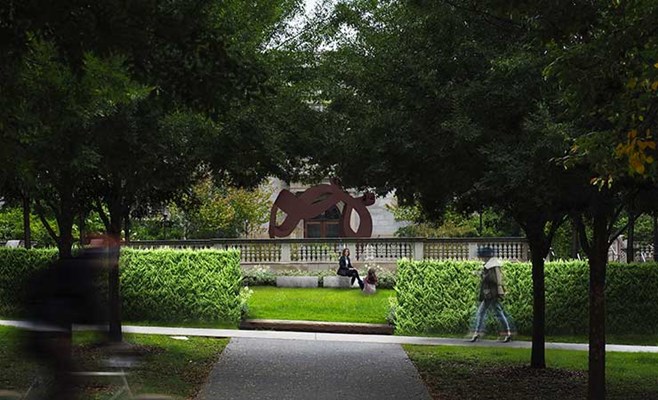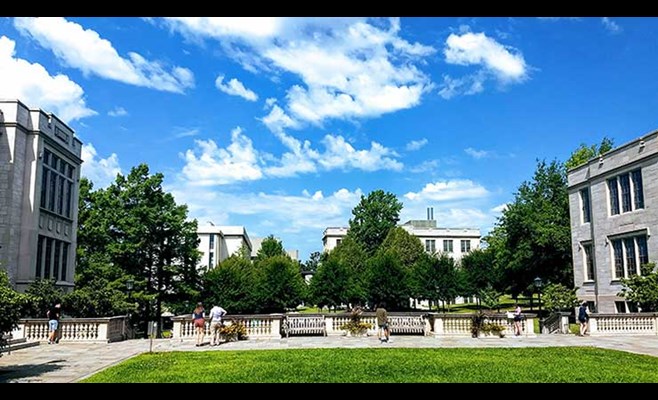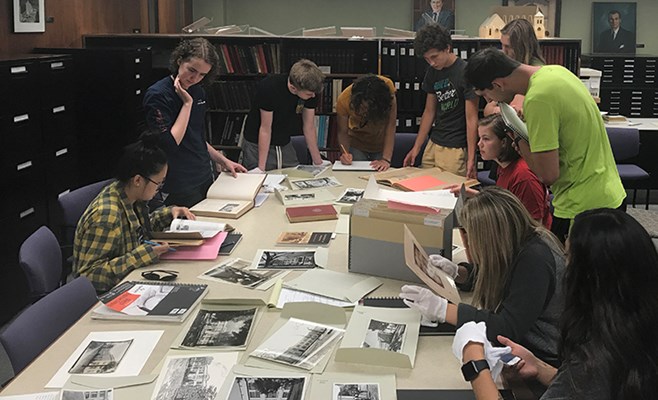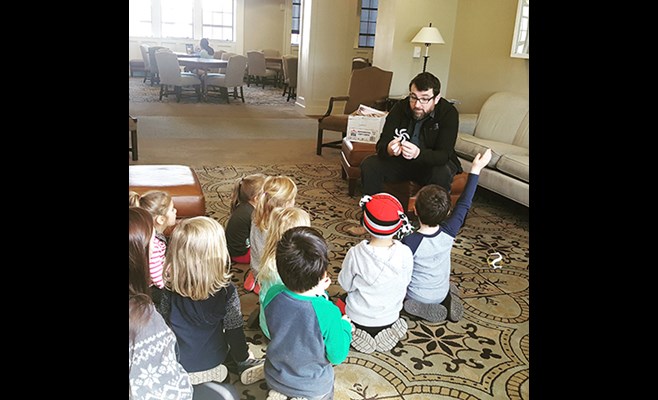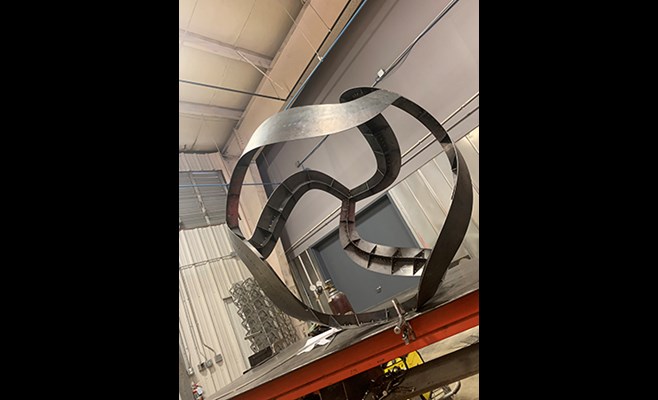Courtyard Curvahedra to be Installed at Gearhart Hall
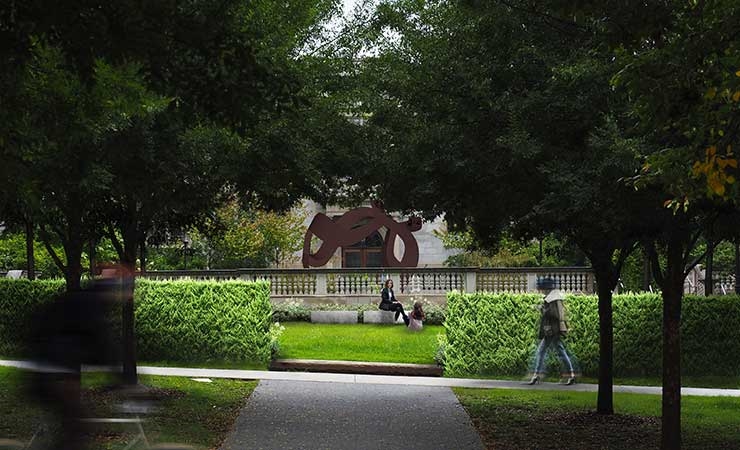
The simple curves of the new Curvahedra sculpture illustrate deep mathematical ideas.
FAYETTEVILLE, Ark. – A new campus landmark will soon be installed in the courtyard of Gearhart Hall. A Curvahedra, a spherical steel structure that is 12 feet in diameter when installed, will sit in the heart of campus at the home of the University of Arkansas Honors College, Graduate School and Geosciences.
The new landmark was made possible by the generosity of David and Jane Gearhart, who funded $50,000 to cover site preparation, fabrication, construction, installation and an honorarium for the principal designers.
“Jane and I are delighted to support this initiative and to have followed it through its development. The sculpture is beautiful, but it also embodies sophisticated ideas about geometry and space,” David Gearhart said. “That seems like a good fit for Gearhart Hall.”
The sculpture was designed by British artist Edmund Harriss, alongside compatriot and collaborator Carl Smith, an associate professor of landscape architecture, and a group of honors students. Honors alumna and assistant professor of architecture Emily Baker solved the puzzle of constructing it.
Harriss is a clinical assistant professor of mathematics in the Fulbright College of Arts and Sciences, and the sculpture is based on his Curvahedra puzzle system, a set of paper pieces that helps users understand how flat pieces can be made to curve into a ball – a bit of magic that can be explained by the Gauss-Bonnet theorem.
“General relativity assumes that the three-dimensional space (or the four-dimensional spacetime) that we live in is itself curved,” Harriss said. “This huge idea fundamentally changed our understanding of the universe, yet we can start to appreciate it with a simple toy.”
The new sculpture will explore this concept on a much grander scale. Harriss’ Curvahedra system has won press in The Guardian newspaper, The Aperiodical and Forbes magazine. Harriss has also partnered with Alex Bellos, an acclaimed science writer and columnist for The Guardian, to produce two coloring books of dizzyingly beautiful geometric patterns. A children’s book, Hello Numbers! What Can You Do?, coauthored with Houston Hughes and illustrated by Brian Rea, was published last fall.
Launched by An Honors Seminar
The idea for a Curvahedra writ large was sparked by an Honors College Signature Seminar in August 2018 titled Place in Mind, which Harriss taught with Smith.
Charged with activating the dormant Gearhart courtyard space, honors students majoring in engineering, art, biology, geology, architecture and landscape architecture used drawing, games, poetry and mathematics to understand the existing qualities of the courtyard and speculate on what it might become in the future.
The honors students explored many options, with several working throughout the fall of 2018 to refine ideas. This process culminated in an exhibition and proposal for the eye-popping Curvahedra in the courtyard to create a sense of place and to foster interaction. The interdisciplinary group relished the opportunity to make their mark on campus:
“It’s kind of rare that I get to exercise the creative side of my brain in my coursework,” said Abby Rhodes, now a senior pursuing a major in geology and a minor in mathematics.
Honors ALumna Leads Construction
Translating a palm-sized paper model into a 12-foot-diameter steel sculpture is no small task. Enter assistant professor of architecture and Honors College Bodenhamer Fellowship alumna Emily Baker, ’04.
She took her first welding class at Batesville High School and honed those skills on design-build projects at the Fay Jones School of Architecture and Design.
Following graduation, she practiced architecture, taught, and earned a master’s degree in architecture from the Cranbrook Academy of Art in Bloomfield Hills, Michigan, where she began exploring the digital side of steel fabrication using the school’s computer numerically controlled plasma cutter.
Recently the American Institute of Steel Construction recognized Baker for her work in structural steel research and teaching, selecting her for the Early Career Faculty Award.
Currently Baker leads the Fay Jones School’s digital steel lab. Over the past year, she has worked long days to figure out how to morph a paper Curvahedra into a massive steel sculpture. Eventually, aided by collaboration with Harriss, she hit on an internal spine that provides the necessary bracing without compromising the piece’s visual impact.
“This is pretty exciting to us — to create something this large in a curved shape, produced at reasonable cost, that’s a feat,” Baker said.
“I love the elegance,” Harriss enthused. “The mathematical idea is so clearly translated into reality.”
Along the way, Baker gave a workshop on their progress at Louisiana State University, describing how to create curving steel forms that “zip” together from flat parts. Baker and Harriss’ method of creating curving beams has been selected for support by Tech Ventures, which is now filing a provisional patent application on their behalf. Baker and Harriss also plan to submit their initial work to the Journal of Art and Mathematics.
Alumnus and civil engineer Gavin Smith, ’13, drew up plans for ground installation, and Arup Engineers analyzed the sculpture as a structure. Fayetteville’s Modus Studio, cofounded by another honors architecture alumnus, Chris Baribeau, ’03, will fabricate the Curvahedra. Installation should be completed by the end of this semester, and Honors College Dean Lynda Coon is already looking forward to spring’s balmy temperatures.
“I shall hold office hours in the Curvahedra!”
About the Honors College: The University of Arkansas Honors College was established in 2002 and brings together high-achieving undergraduate students and the university’s top professors to share transformative learning experiences. Each year the Honors College awards up to 90 freshman fellowships that provide $72,000 over four years, and more than $1 million in undergraduate research and study abroad grants. The Honors College is nationally recognized for the high caliber of students it admits and graduates. Honors students enjoy small, in-depth classes, and programs are offered in all disciplines, tailored to students’ academic interests, with interdisciplinary collaborations encouraged. Fifty percent of Honors College graduates have studied abroad and 100 percent of them have engaged in mentored research.
About the University of Arkansas: The University of Arkansas provides an internationally competitive education for undergraduate and graduate students in more than 200 academic programs. The university contributes new knowledge, economic development, basic and applied research, and creative activity while also providing service to academic and professional disciplines. The Carnegie Foundation classifies the University of Arkansas among fewer than 3% of colleges and universities in America that have the highest level of research activity. U.S. News & World Report ranks the U of A among its top American public research universities. Founded in 1871, the University of Arkansas comprises 10 colleges and schools and maintains a low student-to-faculty ratio that promotes personal attention and close mentoring.
Contacts
Lynda Coon, dean
Honors College
479-575-2089, llcoon@uark.edu
Kendall Curlee, director of communications
Honors College
479-575-2024,
kcurlee@uark.edu
